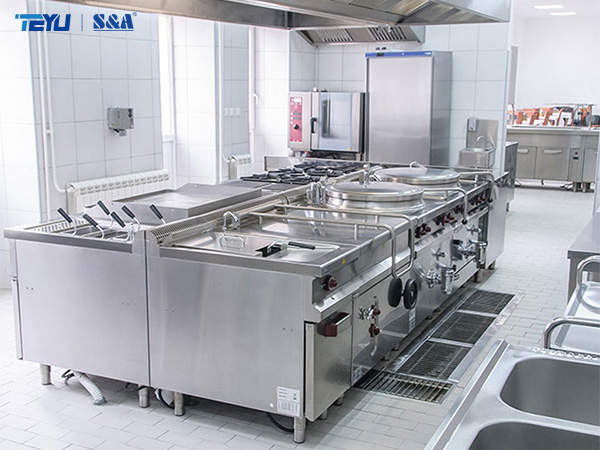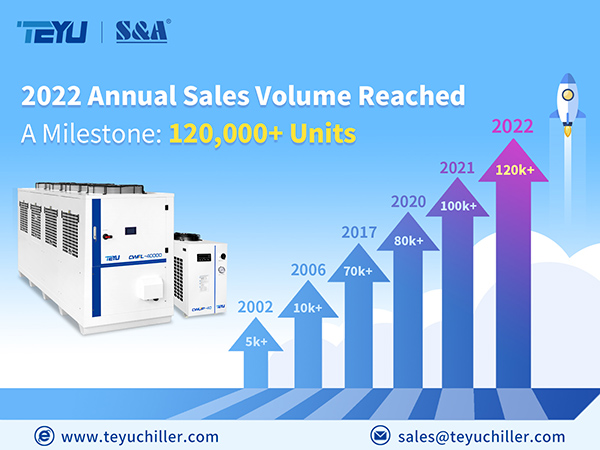As consumers have higher requirements for the quality of metal furniture, it needs laser processing technology to show its advantages in design and beautiful craftsmanship. In the future, the application of laser equipment in the field of metal furniture will continue to increase and become a common process in the industry, continuously bringing incremental demand for laser equipment. Laser chillers will also continue to develop to adapt to changes in the cooling requirements of laser processing equipment.
Application of Laser Processing in Metal Furniture Manufacturing
The furniture industry is known for its ever-changing styles, with wood, stone, sponge, fabric, and leather being popular traditional materials. However, there has been an increasing market share for metal furniture in recent years, with stainless steel being the primary material, followed by iron, aluminum alloy, cast aluminum, and others. The shiny metal texture of stainless steel, along with its durability, rust resistance, and ease of cleaning has gained significant attention in the furniture industry. It is used as the main load-bearing structure for tables, chairs, and sofas, including components such as iron bars, angle irons, and round pipes, with a high demand for cutting, bending, and welding. Metal furniture includes household furniture, office furniture, and furniture in public places. It can be used independently as a product or combined with glass, stone, and wood panels to create a complete set of furniture, which is widely popular among people.
Laser Cutting Improves Metal Furniture Manufacturing
Metal furniture includes pipe fittings, sheet metal, rod fittings, and other components. The traditional processing of metalworking involves complex and time-consuming work, with high labor costs, which creates significant development bottlenecks for the industry. However, the development of laser technology has revolutionized the practicality of laser cutting machines, which has significantly reduced costs and increased efficiency in the metal furniture industry.
In the production process of metal furniture, metal planes, and metal plate cutting are involved. Laser cutting technology has become the main accelerator for this change, providing benefits such as arbitrary shapes, adjustable sizes and depths, high precision, high speed, and no burrs. This has greatly improved productivity, met the diverse and customized demands of consumers for furniture, and led the manufacturing of metal furniture into a new era.

Cutting and Welding of Stainless Steel Furniture
Regarding metal furniture, it is essential to mention stainless steel furniture, which is currently one of the most popular types. Stainless steel furniture is mostly made of food-grade 304 stainless steel, which has strong corrosion resistance and a high degree of surface smoothness. Stainless steel has a long service life, no paint or glue, and does not emit formaldehyde, making it an environmentally friendly furniture material.
The thickness of the sheet used in stainless steel furniture is generally less than 3mm, and the wall thickness of the pipe is less than 1.5mm. The currently mature 2kW fiber laser cutting machine can easily achieve this, with a processing efficiency of more than five times that of traditional mechanical cutting. Additionally, the cutting edge is smooth, without any burrs, and requires no secondary polishing, which greatly saves labor and cost for furniture manufacturers.
Stainless steel furniture involves some curved and bent parts that require stamping or bending, rather than laser processing.
When it comes to assembling complete sets of furniture, welding technology is mostly used to connect stainless steel parts, in addition to screws and fasteners. In the past, argon arc welding and resistance welding were commonly used, but spot welding was inefficient and often resulted in uneven welding and lumpy bumps at the joints. This required manual polishing and smoothing of the nearby stainless steel materials, followed by silver oil spraying, resulting in multiple processes.
Over the past few years, handheld laser welding equipment has gained popularity due to its lightness, flexibility, strong adaptability, high efficiency, and stable welding. As a result, it has replaced argon arc welding in many applications. With an estimated annual consumption of nearly 100,000 units, the required power for handheld laser welding ranges from 500 watts to 2,000 watts. Handheld laser welding can well solve the problem of traditional welding on stainless steel furniture, flexible for arc splicing and angle iron turning edge connection, with good welding stability, and needs no filler or specific gas. It is the preferred process for welding stainless steel materials with small thicknesses due to its increased efficiency and reduced labor costs.
The Development Trend of Laser in Metal Furniture Field
Laser equipment has penetrated rapidly into furniture manufacturing in recent years. Laser cutting is highly automated and produces cuts at extremely fast speeds. Typically, a furniture factory has three or more laser cutting machines that can meet the production capacity. Due to various metal furniture styles and shape design customization, welding of components tend to be more reliant on manual labor. As a result, one welder typically requires one welding machine for handheld laser welding, leading to an increased demand for laser welding equipment.
As consumers have higher requirements for the quality of metal furniture, it needs laser processing technology to show its advantages in design and beautiful craftsmanship. In the future, the application of laser equipment in the field of metal furniture will continue to increase and become a common process in the industry, continuously bringing incremental demand for laser equipment.

Supporting Cooling System for Laser Processing
Laser processing equipment to operate stably and continuously, it must be equipped with a suitable laser chiller for precise temperature control to reduce consumables, improve processing efficiency and extend equipment lifespan. TEYU laser chiller has 21 years of refrigeration experience, with more than 90 products used in over 100 industries (laser cutting machine chiller for laser cutting, laser welding chiller for laser welding, and corresponding handheld welding chiller for handheld laser welder). Featuring temperature precision up to ±0.1°C, plus stable and efficient cooling, TEYU Chiller is the best temperature control partner for your laser equipment!

We're here for you when you need us.
Please complete the form to contact us, and we'll be happy to help you.










































































































